In recent years, the field of machining has undergone significant transformation, moving from traditional methods to more advanced techniques. Among these, 5-axis CNC machining stands out as a pinnacle of modern technology. Often perceived as a highly sophisticated and costly option, 5-axis machining is frequently associated with complexity in both operation and investment. But does this technology truly live up to its daunting reputation?
Continue reading as we delve into the realities of 5-axis CNC machining, exploring its intricacies, benefits, and challenges to provide a comprehensive understanding of this cutting-edge process.
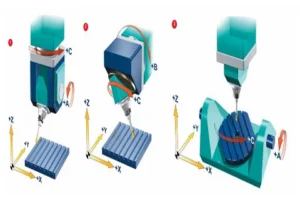 What Is 5 Axis Machining?
What Is 5 Axis Machining?
This machining process utilizes a tool that operates along five different axes, enabling it to rotate and maneuver around the workpiece. Known as a multi-axis subtractive manufacturing technique, 5-axis machining involves shaping the material through movements in five distinct directions: the traditional X, Y, and Z axes, complemented by rotations around the A and B axes. This capability allows operators to machine a part from virtually any angle in a single setup, thus eliminating the need for manual repositioning of the workpiece between operations. This not only saves time but is also perfect for fabricating complex components that demand high precision.
What Does “5” in the 5 Axis Stand For?
 The “5” in 5-axis refers to the total number of axes along which the machine operates. In addition to the standard three axes—X, Y, and Z—that are common in conventional machining, 5-axis machining incorporates two additional axes. The fourth axis, known as the A axis, allows for rotation around the X axis, while the fifth axis, the B axis, enables rotation around the Y axis.
The “5” in 5-axis refers to the total number of axes along which the machine operates. In addition to the standard three axes—X, Y, and Z—that are common in conventional machining, 5-axis machining incorporates two additional axes. The fourth axis, known as the A axis, allows for rotation around the X axis, while the fifth axis, the B axis, enables rotation around the Y axis.
These extra axes significantly expand the capabilities of the machine, allowing it to execute more complex cuts and achieve greater detail in the finished product.
Why Use CNC For 5-Axis Machining?
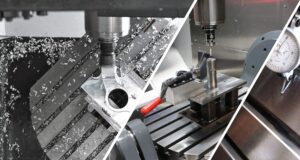 This process is carried out using a 5-axis CNC machine, which combines three linear axes with two rotational axes to simultaneously work in harmony. By integrating a fifth axis, the machine enables engineers and machinists to access and machine up to five faces of a workpiece in a single setup.
This process is carried out using a 5-axis CNC machine, which combines three linear axes with two rotational axes to simultaneously work in harmony. By integrating a fifth axis, the machine enables engineers and machinists to access and machine up to five faces of a workpiece in a single setup.
The adoption of 5-axis CNC machining brings substantial benefits to manufacturers by reducing manufacturing time and costs, thereby accelerating the speed at which products reach the market. It’s important to note that the specific capabilities, including the speed and direction of the CNC machine, are largely determined by its type and configuration.
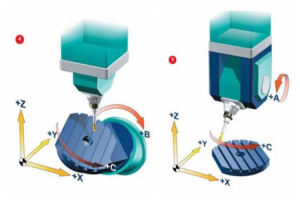 How Does A 5 Axis CNC Machine Work?
How Does A 5 Axis CNC Machine Work?
A 5-axis CNC machine operates with substantial autonomy, requiring minimal human oversight. It employs rotating cutting tools to sculpt materials secured on the machine’s platen.
However, the placement of the material on the platen represents the final step in the 5-axis CNC machining workflow. Initially, the process begins with the creation of a CAD (Computer-Aided Design) model of the part, which is then converted into CAM (Computer-Aided Manufacturing) software. This software is essential for generating the G-code, the CNC machine’s programming language.
Following this, the G-code is loaded into the 5-axis CNC machine. This code is crucial as it provides detailed instructions for the machine, outlining the toolpath and specifying the appropriate tools for the machining process.
Types of 5-Axis CNC Machines
5-axis CNC machines are pivotal in modern manufacturing processes, offering the ability to machine complex parts with high precision. These machines vary primarily in the configuration of their rotary axes, which significantly influences their operational capabilities and suitability for different manufacturing tasks. Here’s an overview of the different types of 5-axis CNC machines based on their axis configurations:
 Head/Head Configuration In this design, both rotary axes are integrated into the machine head itself. This setup minimizes the risk of tool interference because the spindle head operates independently on a stable platform, with the workpiece securely fixed on a stationary table. The fixed position of the table ensures that the workpiece does not move, allowing the machine head to maneuver around the part. This configuration is particularly beneficial for machining large components, although it does have a restricted range of movement along the rotary axes.
Head/Head Configuration In this design, both rotary axes are integrated into the machine head itself. This setup minimizes the risk of tool interference because the spindle head operates independently on a stable platform, with the workpiece securely fixed on a stationary table. The fixed position of the table ensures that the workpiece does not move, allowing the machine head to maneuver around the part. This configuration is particularly beneficial for machining large components, although it does have a restricted range of movement along the rotary axes.
Table/Head Configuration This type of 5-axis machine features one rotary axis in the head and the other on the table. The axis in the head typically has a limited range of motion, while the axis on the table can rotate without restriction. This setup allows continuous rotation of the part, enhancing the machine’s ability to handle complex machining processes without reaching rotational limits. However, the dependency on the table’s rotary axis to support the workpiece limits the size and number of parts that can be machined simultaneously.
Table/Table Configuration Both rotary axes are located on the table in this machine type. This arrangement severely restricts the movement of one axis but allows unrestricted rotation on the other, making it ideal for tasks such as machining undercuts. The Table/Table configuration typically has a smaller operational envelope and is slower than other types due to the absence of dedicated motors found in other configurations. It is also less capable of handling large or heavy parts due to its limited support capabilities.
Each type of 5-axis CNC machine offers unique advantages and limitations, making them suitable for specific applications in the manufacturing industry. Choosing the right machine type depends on the specific requirements of the production task, including part size, complexity, and precision needs.
Benefits of 5-Axis CNC Machining
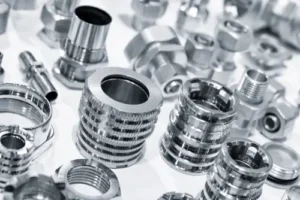 The introduction of 5-axis CNC machining has revolutionized the manufacturing industry by enabling the machining of complex shapes and improving the efficiency and quality of production. Here are the key advantages of using 5-axis CNC machines:
The introduction of 5-axis CNC machining has revolutionized the manufacturing industry by enabling the machining of complex shapes and improving the efficiency and quality of production. Here are the key advantages of using 5-axis CNC machines:
1. **Complex Geometries and Shapes**
The addition of two extra axes in 5-axis CNC machining allows for the creation of intricate designs and complex geometries that were previously difficult or impossible to achieve with traditional machining. This capability eliminates the need for multiple special fixtures, enabling the machine to easily handle complicated angles and arcs in a single setup.
2. **Enhanced Precision and Repeatability**
Unlike manual machining, which often requires multiple setups that can introduce variability and errors, 5-axis CNC machining minimizes the number of setups needed. This reduction in manual repositioning enhances the overall precision and repeatability of the machining process. The use of shorter cutting tools not only extends tool life but also ensures consistent quality across multiple productions.
3. **Streamlined Setup Operations**
Setting up a 5-axis CNC machine is generally simpler and quicker than setting up a traditional 3-axis machine. This is because the 5-axis machine can access five sides of a part in a single setup, reducing the need for multiple setups and allowing for the machining of complex parts with fewer interruptions.
4. **Superior Surface Finish**
The capability to position the workpiece closer to the cutting tool, facilitated by the additional axes, helps achieve a superior surface finish. The use of shorter cutting tools reduces vibrations, which in turn minimizes tool marks on the finished product. This is particularly beneficial in achieving a high-quality finish on detailed and angled surfaces.
5. **Increased Production Efficiency**
5-axis CNC machining significantly cuts down both machining time and the time needed for auxiliary tasks. With high spindle speeds and feed rates, these machines support powerful, large-capacity cutting. The era of high-speed machining with 5-axis technology enhances rapid movement and positioning, dramatically reducing the time from start to finish of production cycles.
These benefits make 5-axis CNC machining a valuable asset in various industries, including aerospace, automotive, medical, and more, where precision, efficiency, and quality are paramount.
Drawbacks of 5-Axis CNC Machining
 While 5-axis CNC machining brings numerous benefits to precision manufacturing, it also comes with certain challenges and limitations. Here are some of the primary drawbacks associated with this technology:
While 5-axis CNC machining brings numerous benefits to precision manufacturing, it also comes with certain challenges and limitations. Here are some of the primary drawbacks associated with this technology:
1. **Increased Cost**
The initial investment for a 5-axis CNC machine is significantly higher than for a simpler 3-axis model. This includes not only the cost of the machine itself but also the software required to operate it effectively. Additionally, maintaining a 5-axis machine tends to be more complex and costly, making it a considerable financial commitment.
2. **Complex Programming Requirements**
Programming for 5-axis machining is notably more intricate than for 3-axis machining due to the integration of two additional rotational axes. This complexity can complicate the toolpath planning, requiring careful coordination to avoid potential collisions and ensure efficient machine operation. Advanced programming is necessary to achieve the high levels of precision and surface quality that 5-axis machines are capable of.
3. **Demand for Skilled Operators**
Operating a 5-axis CNC machine requires a higher level of expertise and training compared to more traditional machines. The advanced capabilities of these machines necessitate skilled operators who can fully leverage their potential. This demand for highly skilled personnel can lead to increased labor costs and a need for ongoing training and development.
These challenges highlight the need for careful consideration when deciding whether to integrate 5-axis CNC machining into a production environment, balancing the advanced capabilities against the higher costs and increased operational complexity.
What Kind Of Parts Can Be Machined Using A 5-Axis Machining Center?
5-axis CNC machining centers enable the production of a diverse array of parts characterized by complex geometries and intricate details. Here are some examples of parts that are well-suited for fabrication using 5-axis machining technology:
 Highly Complex Parts
Highly Complex Parts
5-axis machining is particularly beneficial for creating parts with sophisticated surfaces that are common in industries such as aerospace, automotive, and electronics. The advanced capabilities of 5-axis machines allow for the precise crafting of components with complex contours like turbine blades, spherical surfaces, marine propellers, and impellers.
Disc-Shaped Parts
This type of machining is optimal for producing disc-shaped components found in unmanned aerial vehicles (UAVs) and other applications. It is adept at handling parts that require precise holes on their faces or peripheries, such as those found in motor covers and various mounting plates. The choice between using a horizontal or vertical machining center for these tasks depends on the orientation of the holes required.
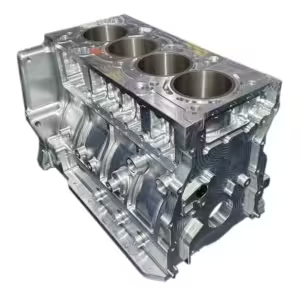 Box-Type Parts
Box-Type Parts
Conventional machining of box-shaped components can be challenging due to the need for multiple setups and alignments. 5-axis machining simplifies this process by allowing simultaneous access to multiple faces of the part, thereby enhancing the precision and reducing the production time of these geometrically complex assemblies.
Irregularly Shaped Parts
Parts with unconventional geometries that combine points, lines, and curved surfaces can be particularly challenging to manufacture with standard machining equipment. 5-axis machining alleviates these challenges by enabling flexible positioning and orientation, which is crucial for maintaining optimal clamping and machining conditions throughout the production process.
Difference Between 5 Axis And 3+2 Axis Machining
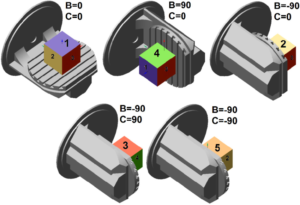 Many people are not aware of the distinctions between 5-axis machining and 3+2-axis machining, or even the differences among 3-axis, 4-axis, and 5-axis CNC machining. In 5-axis machining, the cutting tool continuously rotates along five axes, allowing for complex geometries and surfaces to be machined efficiently.
Many people are not aware of the distinctions between 5-axis machining and 3+2-axis machining, or even the differences among 3-axis, 4-axis, and 5-axis CNC machining. In 5-axis machining, the cutting tool continuously rotates along five axes, allowing for complex geometries and surfaces to be machined efficiently.
In contrast, 3+2-axis machining involves a combination of 3-axis machining with the tool locked at a specific angle determined by two additional rotary axes. This method does not involve continuous tool rotation like in 5-axis machining.
The primary advantage of 5-axis machining over 3+2-axis machining is speed. In 3+2-axis machining, the process frequently pauses to adjust the tool’s orientation, which can slow down the operation. Conversely, 5-axis machining operates seamlessly in a single continuous process without the need for stopping, resulting in faster production times.
Maximizing the Potential of 5-Axis CNC Machines
To fully leverage the capabilities of a 5-axis CNC machine, it is essential to understand and utilize its extensive functionalities. Here are some strategies to help you optimize the use of a 5-axis CNC machine:
Choose Appropriate Software and Controls The first step in harnessing the power of a 5-axis CNC mill is to ensure you have accurate and precise design data. It is crucial to validate the design for accuracy and feasibility before converting the CAD model into a CAM program. This validation process helps in selecting the best CAD/CAM software and control systems tailored to your specific manufacturing needs. Advanced simulation software plays a vital role here, allowing you to monitor part dimensions, check for any potential interference, and assess tool lengths effectively.
Moreover, with accurate design data, you can perform a thorough cost analysis, ensuring that you select the most efficient and cost-effective manufacturing process for your project.
Implement a Tool Detection System Choosing the correct tool is fundamental to achieving high-quality machining results and maintaining operational efficiency. Incorrect tool selection can lead to increased wear, potential breakage, and higher production costs, not to mention compromised product quality. Implementing a tool detection system can greatly reduce these risks. This system evaluates whether the selected tools are suitable for the tasks at hand, thereby minimizing errors and enhancing overall productivity.
Utilize Collision Prevention Software One of the significant risks in complex machining operations is the possibility of collisions, which can damage both the workpiece and the machine, leading to costly downtime and repairs. To prevent this, it is advisable to use advanced collision detection software. Such software simulates the entire machining process in advance, identifying and alerting operators to potential collisions. This foresight allows for adjustments in the machining commands to avoid any issues. Popular options for collision prevention software include Predator and ModuleWorks, known for their reliability and comprehensive simulation capabilities.
By implementing these strategies, operators can significantly improve the efficiency and output quality of 5-axis CNC machining operations, ensuring optimal use of the technology and resources.
Industries Applications Benefiting From 5-Axis CNC
 5-axis CNC machining offers numerous advantages to various industries, including enhanced precision, reduced human error, and consistent high-quality output. This advanced technology is particularly crucial in sectors where accuracy and reliability are paramount. Here are some key industries that benefit significantly from 5-axis CNC machining:
5-axis CNC machining offers numerous advantages to various industries, including enhanced precision, reduced human error, and consistent high-quality output. This advanced technology is particularly crucial in sectors where accuracy and reliability are paramount. Here are some key industries that benefit significantly from 5-axis CNC machining:
Medical Industry In the medical field, the margin for error is exceptionally low as any malfunction can lead to critical failures during surgeries or diagnostics. 5-axis CNC machining is integral in manufacturing complex and highly precise components such as surgical instruments, implants, orthotic devices, and equipment for MRI machines. The ability to produce intricate parts reliably is crucial for patient safety and the effectiveness of medical treatments.
Electronics Industry The electronics industry relies heavily on the precise and efficient production of small and complex components that are essential for the functionality of various devices. 5-axis CNC machining is used to create parts like semiconductor housings, metal slats, heat sinks, and components for printed circuit boards. This technology ensures the components fit perfectly, enhancing device performance and reliability.
Energy Industry In the energy sector, the accuracy of component manufacturing can directly impact operational safety and efficiency. 5-axis CNC machining is employed to produce essential parts such as drill bits, pistons, rods, cylinders, and valves. The ability to adhere to strict specifications helps prevent system failures and downtime, which can be costly in terms of both safety and financial loss.
Aerospace Industry Aerospace components often feature complex geometries and require extremely precise machining. 5-axis CNC technology is ideal for creating parts with intricate shapes and contoured edges, such as turbine blades and structural components. The superior precision and capability to handle complex designs ensure that these components meet the rigorous standards of the aerospace industry, contributing to safer and more efficient aircraft.
Get Started With 5-Axis Machining at AS Prototypes
5-axis CNC machining streamlines the manufacturing process, enhancing speed, cost-efficiency, and precision. For optimal results, expertise in this advanced technology is crucial.
AS Prototypes is a globally recognized leader in CNC machining services. We are equipped with state-of-the-art 5-axis CNC machines, ensuring top-quality parts, competitive pricing, and swift delivery times.
Beyond 5-axis machining, AS Prototypes is a pioneer in a wide range of machining solutions, consistently leading in technological advancements. If you have any inquiries or requirements related to precision 5-axis machining, don’t hesitate to contact us or request a quote.
FAQs
What programming language do 5-axis CNC machines utilize?
5-axis CNC machines primarily operate using G-code. This programming language provides a comprehensive set of instructions that guide the machine’s cutting tool during operations.
What types of materials can be machined using a 5-axis CNC machine?
A wide variety of materials can be processed with 5-axis CNC machining. Commonly used materials include metals such as aluminum, brass, copper, titanium, and steel, as well as plastics like polypropylene, ABS, polycarbonate, nylon, and POM.
